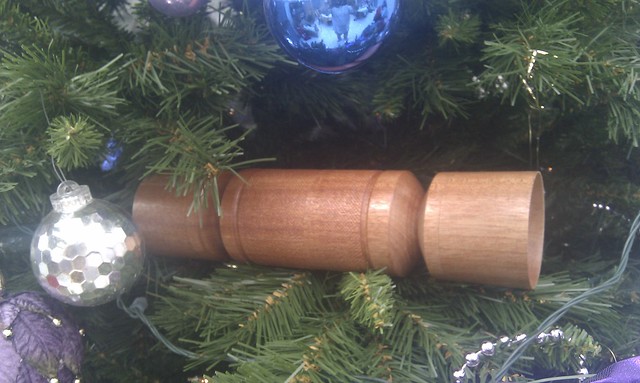nev
Established Member
Blisters original suggestion. A Christmas Cracker!
I have no idea if this will work as I've never tried it, but here goes..
The challenge is to make a Christmas cracker that can be 'pulled' - so two 'halves' that slide or twist apart to reveal a novelty inside a la traditional cracker.
The novelty can be anything you like from a simple ring to a scale model of HMS Victory as long as its turned or made from turned parts.
****JUDGING WILL BE OF THE CRACKER ALONE REGARDLESS OF THE CONTAINED NOVELTY. ****
This will make Richards life a little easier and the judging fairer. (one may be the best cracker but not have the best novelty item) so...
A BONUS 3 POINTS WILL BE AWARDED FOR WHAT THE JUDGE DETERMINES TO BE THE BEST NOVELTY ITEM. So as with all crackers there may be a little something extra inside worth getting 8)
Both the cracker and the novelty are...
All parts to be turned on the (wood) lathe using wood turning tools. (it is a turning challenge after all )
)
Can be made from any materials as long as they are turned using wood turning tools.
No minimum or maximum size.
Colouring / texturing / burning allowed
Glue can be used to assemble cracker/ novelty.
The novelty can be disassembled to fit in the cracker as long as no tools or glue etc are required to assemble it (after all it will be on the xmas dinner table!) (hammer)
Any entry's that are outside the rules and requirements will not be judged
The Judges decision is final ( Any negative comments re judging must be via PM only and not on the open forum )
NO Critique or comments on any work until December Please, After the Judging and results.
Please state wood type if known, dimensions and a little about how you made it and what tools and finish you used ( this helps the judge )
Please post 3 images of your work / entry
1 showing the cracker
1 showing the novelty
1 showing the fit of the join of the halves
Image size please use image size 640 x 480 0.3 mp, same previous months
Entry’s to be uploaded from 10pm on 27th Dec up until 10pm on the 29th Dec. after this time the thread will be locked for Judging
Results will be given on or before 31 Dec
Roundup
I have no idea if this will work as I've never tried it, but here goes..
The challenge is to make a Christmas cracker that can be 'pulled' - so two 'halves' that slide or twist apart to reveal a novelty inside a la traditional cracker.
The novelty can be anything you like from a simple ring to a scale model of HMS Victory as long as its turned or made from turned parts.
****JUDGING WILL BE OF THE CRACKER ALONE REGARDLESS OF THE CONTAINED NOVELTY. ****
This will make Richards life a little easier and the judging fairer. (one may be the best cracker but not have the best novelty item) so...
A BONUS 3 POINTS WILL BE AWARDED FOR WHAT THE JUDGE DETERMINES TO BE THE BEST NOVELTY ITEM. So as with all crackers there may be a little something extra inside worth getting 8)
Both the cracker and the novelty are...
All parts to be turned on the (wood) lathe using wood turning tools. (it is a turning challenge after all
Can be made from any materials as long as they are turned using wood turning tools.
No minimum or maximum size.
Colouring / texturing / burning allowed
Glue can be used to assemble cracker/ novelty.
The novelty can be disassembled to fit in the cracker as long as no tools or glue etc are required to assemble it (after all it will be on the xmas dinner table!) (hammer)
Any entry's that are outside the rules and requirements will not be judged
The Judges decision is final ( Any negative comments re judging must be via PM only and not on the open forum )
NO Critique or comments on any work until December Please, After the Judging and results.
Please state wood type if known, dimensions and a little about how you made it and what tools and finish you used ( this helps the judge )
Please post 3 images of your work / entry
1 showing the cracker
1 showing the novelty
1 showing the fit of the join of the halves
Image size please use image size 640 x 480 0.3 mp, same previous months
Entry’s to be uploaded from 10pm on 27th Dec up until 10pm on the 29th Dec. after this time the thread will be locked for Judging
Results will be given on or before 31 Dec
Roundup



























































